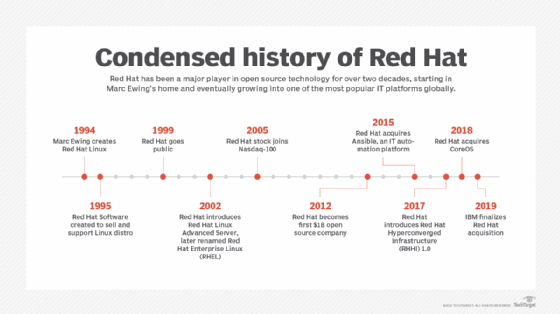
Getty Images
The Red Hat ecosystem: Then vs. now
Red Hat remains one of the most influential open source companies. Linux no longer stands at the center of the Red Hat ecosystem -- but it hasn't disappeared from it either.
Once upon a time, the Red Hat ecosystem was oriented around one platform: Red Hat Enterprise Linux.
Those days are gone.
While RHEL remains one pillar of Red Hat's offerings, the Red Hat ecosystem evolved to include a variety of other products and services through acquisitions and new development. Concurrently, key facets of the relationship between Red Hat, Linux and open source have changed in important ways.
Let's examine the state of the Red Hat ecosystem in the 2020s and its relationship to the larger software market. We'll look at the major products and services Red Hat offers -- and how those services interact with third-party tools and software, such as Linux distributions based on RHEL.
A brief history of Red Hat
Red Hat's history dates back to 1994, when Marc Ewing created Red Hat Linux. Initially, Red Hat Linux was just an open source software platform. It wasn't until the following year that a company, Red Hat Software, was created to sell and support the Linux distribution.
Red Hat grew quickly throughout the later 1990s and went public in 1999. The same year, it acquired Cygnus Solutions, a major provider of support services for free and open source software. Over the following 20 years, Red Hat acquired several more open source companies, including JBoss, Ansible and CoreOS, and IBM acquired Red Hat in 2019 for $34 billion.
From the start, Red Hat's business was founded on two main pillars: develop a Linux distribution and provide related support services.

The evolution of Red Hat
Fast-forward to the present, and the Red Hat ecosystem looks little like it did circa 1999. RHEL is still part of Red Hat's portfolio, along with its support services. But Red Hat has grown much broader and more dynamic over the past 20 years.
These are the major components of the Red Hat world as they exist today:
Linux distributions
RHEL remains one of Red Hat's flagship products, but it's no longer a single platform. Instead, RHEL is available in both its traditional form, called RHEL Server, as well as in a form optimized for container hosting, called RHEL Atomic Host.
Kubernetes
Kubernetes, the ubiquitous open source container orchestrator, is a major area of focus for Red Hat, as OpenShift -- Red Hat's application hosting platform -- is based on Kubernetes.
Things didn't start out this way. Originally, OpenShift was a platform as a service developed by Makara, a company that Red Hat acquired in 2010. But with the release of OpenShift version 3 in 2016, the platform migrated to a Kubernetes core.
Some important differences remain between OpenShift and other Kubernetes distributions, but basically, OpenShift is Kubernetes with Red Hat tools baked in.
Red Hat also offers Quay, a container image registry that can be used in conjunction with OpenShift.
Configuration management and automation
Red Hat is the main corporate backer of Ansible, a company Red Hat acquired in 2015. Ansible is an open source automation tool for tasks like configuration management and application deployment. While Ansible itself is not a centerpiece of Red Hat's portfolio, it plays an important role in management and integration with other Red Hat tools.
Storage
Red Hat provides two open source scale-out storage platforms, Ceph and GlusterFS, which enable IT teams to build scalable storage in the cloud or on premises.
Arguably, platforms like these have become less important in the age of cheap and easy-to-use cloud storage services, but they remain valuable for businesses that want to store massive volumes of data without having to pay for -- or be locked into -- a public cloud service.
Cloud services
It would be a stretch to call Red Hat a public cloud platform -- but not too much of a stretch.
The company offers its own hosted OpenShift service, called OpenShift Online, which enables customers to deploy OpenShift on Red Hat-managed infrastructure. In addition, many of Red Hat's products, such as OpenStack and RHEL-based virtual server images, are available on all major public cloud providers.
Red Hat, vis-a-vis the open source ecosystem
In addition to expanding its product and service offerings, Red Hat has seen some significant shifts in its relationship with the rest of the software industry -- especially the open source segment -- in more recent years.
One major change was IBM's acquisition of Red Hat, which closed in summer 2019. Red Hat continues to resemble an independent company in most respects: Its products and services remain compatible with those of IBM's competitors, for example. Still, the IBM acquisition means Red Hat no longer has foundations that lie purely in the realm of open source. IBM has long been a backer of open source software, but it's not an open source company itself, as many of its products are and remain closed source. Red Hat, as an IBM subsidiary, no longer occupies the position it once did within the open source ecosystem.
Red Hat's decision in late 2020 to discontinue CentOS development had a similar effect. CentOS, a Linux distribution that was, essentially, a clone of RHEL, provided a means by which businesses could run RHEL without paying the licensing fees. The company's decision to cease CentOS support left some open source advocates feeling slighted.
However, several CentOS-derived Linux distributions continue to exist, which means IT orgs that want the RHEL experience CentOS offered can still get it -- without actually using RHEL. This interaction requires a different distro, such as Rocky Linux or AlmaLinux, both of which promise binary compatibility with RHEL.






